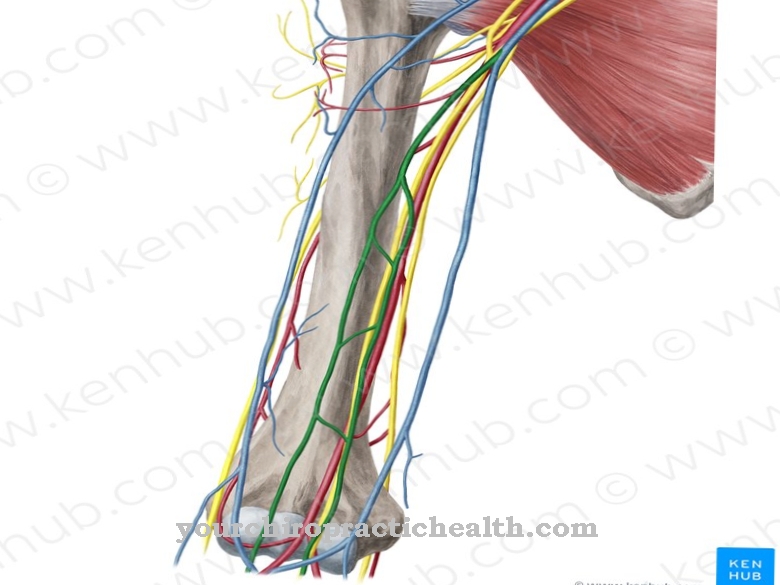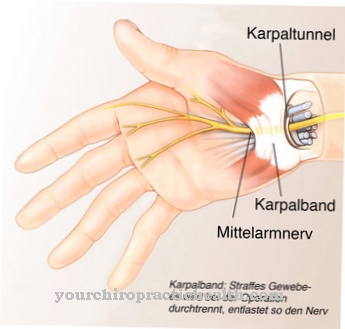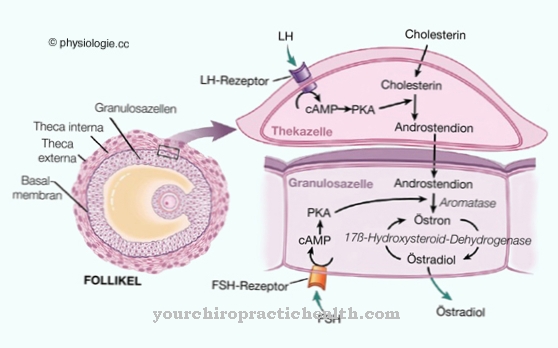As coccyx is the lowest section of the spine below the sacrum. It consists of 4 to 5 small vertebrae, the original joints of which have mostly grown together to form a complete bone structure. The coccyx serves primarily as a starting point for the tendons and ligaments of the pelvic floor and hip.
What is the tailbone?

The tailbone (coccyx) is the lowest part of the spine, directly adjacent to the sacrum. It consists of 4 to 5 vertebrae that appear a little stunted, the vertebral joints of which have usually been stiffened by the body itself through ossification and have mostly grown together to form a complete bone structure.
It is very likely a phylogenetic regression (rudiment) of the tail, which was no longer of use due to the specific way of life of humans and their ancestors. The regression is not complete because the coccyx takes on an important function for the statics of the body as a counter-bearing for the absorption of force by the tendons, ligaments and muscles of the pelvic floor, pelvis and hips. Total dismantling of the coccyx would result in problems with the strength and statics in the area of the hips and pelvis.
Evolutionary regressions can occur when certain body features or physiological transformations change due to random gene mutations. If the changes involve a favorable adaptation to new environmental or living conditions, they will prevail in terms of population genetics. In the opposite case, the gene mutation would not prevail in terms of population genetics and would gradually be lost again.
Anatomy & structure
Characteristic of the coccyx is the growing together of the 4 to 5 tail vertebrae into a single bone body. This process is called synostosis. The originally existing intervertebral discs and cartilage lost their function and were replaced by bone tissue.
The structures of a vertebral body can only be recognized to some extent on the uppermost coccyx vertebra, while the remaining vertebrae, which taper towards the bottom, are so fused together that a conical, bony structure results. The end of the tailbone is formed by a small, button-like piece of bone.
The uppermost coccyx vertebra is connected to the sacrum above, which also consists of five fused vertebrae and is connected to the iliac bone of the pelvis via the fairly firm and poorly mobile sacroiliac joint (sacrum-iliac joint). The sacrum thus forms part of the spine and the ilium at the same time.
Function & tasks
The main function of the coccyx is to take up forces from the grown muscles, ligaments, and tendons of the pelvic floor, pelvis, and hips.
It thus fulfills an important role in the statics of the body. The fact that it grows together to form a coherent bone makes it suitable as a support for the tendons and ligaments of the pelvic floor and hips.
During the embryonic phase, the coccyx protrudes and, as it develops, is surrounded by tissue again long before birth.
A further regression of the coccyx in the course of evolution would require a heavily modified solution for the attachment points of the ligaments and tendons that are currently still using the coccyx.
You can find your medication here
➔ Medicines for back painIllnesses & ailments
The exposed position of the coccyx makes it prone to injuries from falls on the buttocks or direct impacts. It can lead to sprains, bruises or even a painful classic fracture or, less often, a dislocation.
The necessary immobilization of the coccyx to heal the fracture is practically impossible, so that further pain cannot be prevented and can only be treated symptomatically. To relieve the breakage, a ring cushion can be used for sitting positions, which partially transfers the pressure forces that occur to the gluteal muscles. The less common dislocation, which is not always easy to diagnose, can be corrected by an experienced doctor or therapist using the thumb and middle finger. The middle finger is inserted into the rectum in order to push the tailbone back into the correct position, supported by the thumb, which at the same time has to exert external pressure on the coccyx.
If the "reduction" succeeds, pain relief will quickly result. Non-specific pain in the tailbone can go away without treatment. However, if the pain persists and becomes chronic, it is coccygodynia or coccygodynia with very different causes. A common cause of long-lasting pain in the coccyx is inflammation of the tendons, ligaments or muscles at the point of attachment to the coccyx or microtraumas, which are favored by overstressing as a result of an unfavorable sitting posture or unfamiliar, constantly recurring movement patterns.
They can make therapy with anti-inflammatory and analgesic agents necessary, usually lengthy. Nerve irritation due to a herniated disc in the lower part of the lumbar spine can also cause coccygodynia. In rare cases, the disease is caused by tumors.













.jpg)

.jpg)
.jpg)











.jpg)